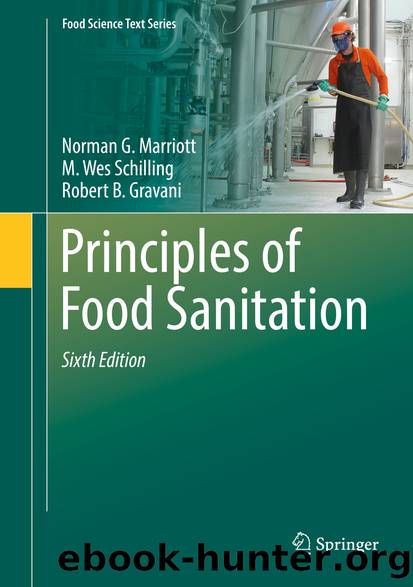Principles of Food Sanitation by Norman G. Marriott M. Wes Schilling & Robert B. Gravani

Author:Norman G. Marriott, M. Wes Schilling & Robert B. Gravani
Language: eng
Format: epub
Publisher: Springer International Publishing, Cham
Cleaning-Out-of-Place
Systems designed for cleaning-out-of-place (COP) require cleaning by disassembly and/or removal from the normal location. The parts are then placed into COP tanks and cleaned using water movement, which removes soil from the components. Fluid flow is utilized in the application of force for cleaning. Regulatory agencies have previously used velocity as a means of measuring the fluid flow force, employing the rule of thumb of 1.5 M/sec (5 feet/sec). This guideline should no longer be emphasized because COP equipment can effectively clean with less velocity. Velocity and turbulence, the actual cleaning force, are not equally related under all conditions of flow.
Many small parts of equipment and utensils, as well as small containers, can be washed effectively in a recirculating parts washer, also called a COP unit. These units, like sanitary pipe washers, contain a recirculating pump and distribution headers that agitate the cleaning solution . Also, a COP unit can serve as the recirculating unit for CIP operation. The normal wash recirculation time is approximately 30–40 min, with an additional 5–10 min for a cold acid or sanitizing rinse.
A COP unit is frequently constructed with a double-compartment stainless steel sink equipped with motor-driven brushes. The same motor also pumps a cleaning solution through a preformatted pipe onto the brushes. Desired temperature of the cleaning solution (45–55 °C) (113–130 °F)is maintained through a thermostatically controlled heater. The first compartment is allocated to use of the cleaning solution. The cleaned parts or utensils are rinsed with a spray nozzle in the second compartment. Drying is normally accomplished by air within the COP unit or on a suitable drain board or rack.
Equipment that functions as a COP unit contains a brush assembly and a rinse assembly. A tank is included for the cleaning solution. Many COP units contain rotary brushes for cleaning both the inside and outside of parts and utensils, with the cleaning solution being introduced through the brushes that clean the inside.
The major appeal of COP equipment is that it can effectively clean parts that are disassembled as well as small equipment and utensils . This equipment can also reduce labor requirements and improve hygiene. COP units are considered reasonable in cost to buy and maintain. Their major limitations for small-volume operations are initial cost, maintenance, and labor requirements for loading and unloading these washers.
The COP concept is frequently used to clean equipment and utensils for the food preparation and foodservice industry. Stainless steel bins may be cleaned and sanitized in an enclosed stainless steel cabinet washer through the use of a computer-controlled cycle. A programmable logic controller governs the timing of each sequential step in the cleaning operation. Further discussion of COP equipment in the dairy and foodservice industries is given in Chaps. 16 and 21.
Download
This site does not store any files on its server. We only index and link to content provided by other sites. Please contact the content providers to delete copyright contents if any and email us, we'll remove relevant links or contents immediately.
| Cell Biology | Developmental Biology |
| Entomology | Marine Biology |
| Microbiology | Molecular Biology |
| Biostatistics |
Sapiens: A Brief History of Humankind by Yuval Noah Harari(14257)
The Tidewater Tales by John Barth(12609)
Mastermind: How to Think Like Sherlock Holmes by Maria Konnikova(7232)
Do No Harm Stories of Life, Death and Brain Surgery by Henry Marsh(6891)
The Thirst by Nesbo Jo(6832)
Why We Sleep: Unlocking the Power of Sleep and Dreams by Matthew Walker(6620)
Life 3.0: Being Human in the Age of Artificial Intelligence by Tegmark Max(5478)
Sapiens by Yuval Noah Harari(5295)
The Longevity Diet by Valter Longo(5021)
The Body: A Guide for Occupants by Bill Bryson(4978)
The Rules Do Not Apply by Ariel Levy(4866)
The Immortal Life of Henrietta Lacks by Rebecca Skloot(4528)
Animal Frequency by Melissa Alvarez(4399)
Why We Sleep by Matthew Walker(4362)
The Hacking of the American Mind by Robert H. Lustig(4319)
Yoga Anatomy by Kaminoff Leslie(4309)
All Creatures Great and Small by James Herriot(4233)
Double Down (Diary of a Wimpy Kid Book 11) by Jeff Kinney(4209)
Embedded Programming with Modern C++ Cookbook by Igor Viarheichyk(4107)
